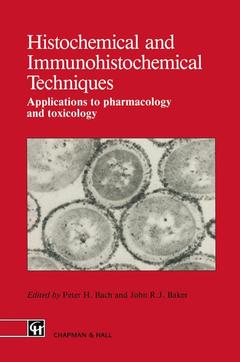Description
Histochemical and Immunohistochemical Techniques, Softcover reprint of the original 1st ed. 1991
Applications to pharmacology and toxicology
Coordinators: Bach Peter H., Baker J.R.J.
Language: English
Keywords
Publication date: 11-2012
289 p. · 15.2x22.9 cm · Paperback
289 p. · 15.2x22.9 cm · Paperback
Description
/li>Contents
/li>
Toxicological and pharmacological effects arise when chemicals interact with biophysiological functions in discrete cell types. There is a continuing need to screen novel compounds for their potential therapeutic effects, and once these have been "discovered" to understand their molecular actions, as the basis of using such compounds safely and for rational drug design. Pharmacology now uses all of the sophisticated molecular research techniques that are available for the development of safer and more efficacious drugs. Histochemistry has been usefully applied to developing new drugs (and assessing chemical safley) and is potentially cost effective. The need to test novel substances for their potential adverse effects has raised many questions. Toxicological pathology has moved away from the cataloging of lesions towards understanding the basis of the events that underly cell injury, especially for those secondary consequences of chemical injury that lead to malignancy and chronic disease. The focal nature of toxicologic lesions de mands the use of microtechniques to provide data to help understand these questions. Histochemistry is under-utilized, but offers one of the key ap proaches necessary to address the problem of understanding interactions between a cell population and a chemical, the modulation of cellular biochem istryor the presence of a lesion in a test animal can be rationalised in terms of species differences that have no relevance to man as opposed to those that are of clinical significance or represent a warning of dire consequences to man.
1 Why use histochemistry for a better understanding of pharmacology and toxicology?.- 2 Whole-body autoradiography of pharmaceuticals and chemicals.- 3 Image analysis, fluorescence and laser microscopy.- 4 The measurement of free calcium to assess cellular function and injury using digital imaging fluorescence microscopy.- 5 Flow cytometry to characterize normal and abnormal cell function.- 6 Quantitative histochemical and cytochemical assays.- 7 Fixation of tissue for histochemistry.- 8 Immunochemical methods to assess cellular malfunction.- 9 Cell markers and processes related to chemically induced carcinogenesis.- 10 The mechanistic basis of chemical- and drug-induced nephrotoxicity.- 11 Pollutant-induced toxicity in the marine environment.
© 2024 LAVOISIER S.A.S.




